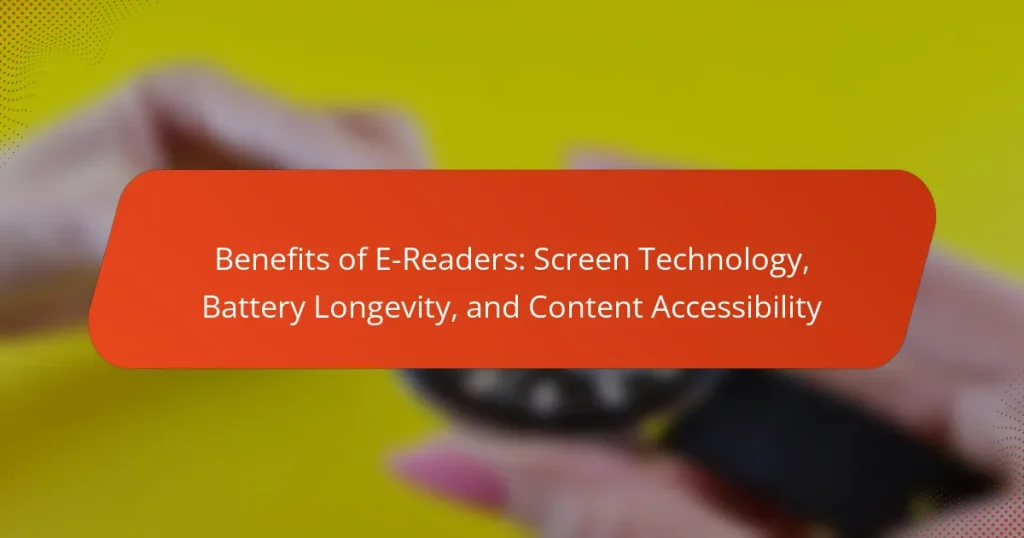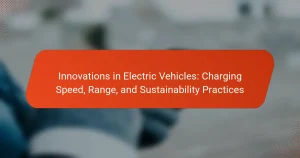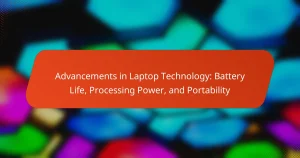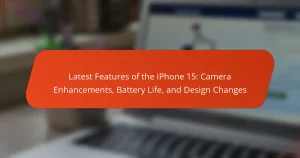E-readers are portable devices designed for reading digital books, offering various advantages over traditional print media. They feature long-lasting battery life, often lasting weeks on a single charge, and screens that reduce glare while mimicking paper for enhanced reading comfort. E-readers improve content accessibility through customizable text sizes, adjustable backgrounds, and built-in tools such as text-to-speech, which benefit users with visual impairments. Additionally, they provide instant access to thousands of titles, built-in dictionaries, and translation tools, making diverse content easily available. Research indicates that e-readers can enhance reading comprehension, particularly for users with learning disabilities, highlighting their role in improving overall reading experiences.
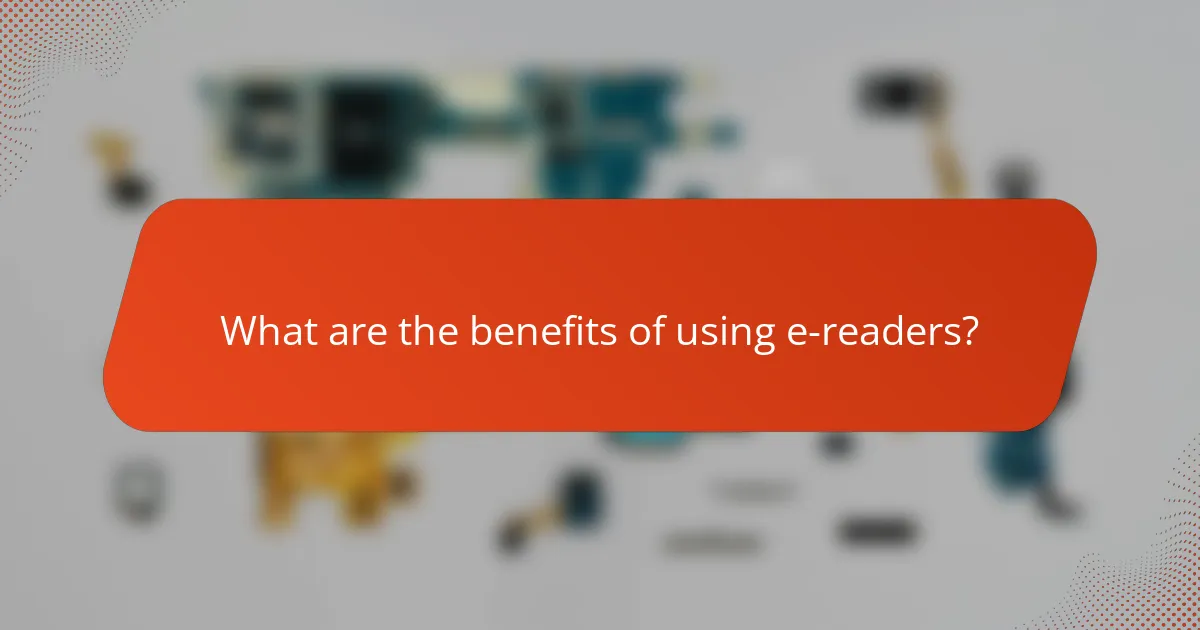
What are the benefits of using e-readers?
E-readers offer several benefits. They provide portability, allowing users to carry multiple books in one device. E-readers have longer battery life compared to tablets and smartphones. Many models can last weeks on a single charge. Their screens reduce glare and mimic paper, enhancing reading comfort. E-readers often include adjustable font sizes and background lighting. This feature improves accessibility for users with visual impairments. Additionally, e-readers allow instant access to thousands of titles. Users can purchase and download books quickly without visiting a store.
How do e-readers enhance the reading experience?
E-readers enhance the reading experience by providing adjustable lighting and font sizes. This customization allows users to read comfortably in various environments. E-readers also feature high-resolution screens that reduce eye strain compared to traditional screens. Many devices use E Ink technology, which mimics paper and enhances readability. Additionally, e-readers offer instant access to thousands of books and materials. This vast library increases the convenience of obtaining new content. E-readers often include built-in dictionaries and note-taking features. These tools support deeper engagement with the text. Furthermore, long battery life allows for extended reading sessions without interruption. Overall, these features collectively improve the overall reading experience.
What features contribute to a better reading experience on e-readers?
E-readers provide several features that enhance the reading experience. High-resolution e-ink displays minimize glare and simulate printed paper. Adjustable front lighting allows for reading in various lighting conditions. Long battery life ensures uninterrupted reading for weeks. Lightweight design enhances portability and comfort during extended use. Customizable font sizes and styles cater to individual preferences. Built-in dictionaries provide instant definitions for unfamiliar words. Access to a vast library of content offers diverse reading options. These features collectively improve user satisfaction and engagement with digital reading.
How do e-readers compare to traditional books in terms of usability?
E-readers offer enhanced usability compared to traditional books. They provide adjustable font sizes and brightness settings, catering to individual reading preferences. E-readers typically allow for easy navigation through content via touchscreens or buttons. Users can highlight text and make notes digitally, streamlining the reading process. Additionally, e-readers can store thousands of titles, eliminating physical space constraints. They often feature built-in dictionaries for quick word lookups, enhancing comprehension. According to a study by the Pew Research Center, 28% of Americans read e-books in 2021, indicating a growing preference for digital reading. This data supports the usability advantages that e-readers present over traditional books.
Why is screen technology important in e-readers?
Screen technology is crucial in e-readers because it directly affects readability and user experience. High-quality screens reduce glare and improve contrast, making text easier to read in various lighting conditions. E-ink technology, commonly used in e-readers, mimics the appearance of printed paper. This reduces eye strain compared to traditional screens. Additionally, screen resolution impacts the clarity of text and images. Higher resolution screens provide sharper text, enhancing overall reading comfort. Research indicates that e-readers with advanced screen technology can lead to longer reading sessions without fatigue. Thus, screen technology significantly enhances the functionality and appeal of e-readers.
What types of screen technology are used in e-readers?
E-readers primarily use E Ink technology, LCD, and LED screens. E Ink screens mimic the appearance of printed paper. They provide excellent readability in direct sunlight. E Ink displays consume very little power, extending battery life. LCD screens offer color and are used in multifunctional devices. They are brighter but can cause more eye strain. LED screens are often backlit, enhancing visibility in low light. Each screen type has distinct advantages and disadvantages.
How does screen technology impact readability and eye strain?
Screen technology significantly impacts readability and eye strain. High-resolution screens enhance text clarity, making reading easier. Conversely, low-resolution screens can blur text, increasing eye strain. Blue light emitted by screens contributes to visual discomfort and fatigue. Research indicates that prolonged exposure to blue light can disrupt sleep patterns. E-ink technology, found in many e-readers, mimics paper and reduces glare. This technology allows for longer reading sessions with less eye strain. Studies show that users of e-ink displays report fewer symptoms of eye fatigue compared to traditional screens. Thus, the choice of screen technology is crucial for minimizing eye strain and improving readability.
What role does battery longevity play in e-reader benefits?
Battery longevity significantly enhances the benefits of e-readers. It allows users to read for extended periods without frequent recharging. Many e-readers can last weeks on a single charge due to energy-efficient technology. This feature promotes convenience for users, especially during travel or long reading sessions. Longer battery life reduces the need for power outlets, making e-readers more portable. Additionally, it encourages reading as users can focus on content rather than battery levels. Overall, battery longevity contributes to a seamless reading experience, enhancing user satisfaction.
How long do e-readers typically last on a single charge?
E-readers typically last for about four to eight weeks on a single charge. This duration depends on factors such as screen brightness and usage frequency. Many e-readers utilize E Ink technology, which consumes minimal power. Consequently, they can sustain long battery life even with regular reading. Some models offer features like adjustable lighting, which can affect battery longevity. For instance, reading with the light on may reduce the battery life to a few weeks. In contrast, reading without backlighting can extend usage significantly. Overall, the efficient power management of e-readers contributes to their impressive battery performance.
What factors influence battery life in e-readers?
Battery life in e-readers is influenced by several key factors. These factors include screen technology, usage patterns, and connectivity options. E-readers typically use E Ink technology, which consumes less power than traditional screens. The frequency of page turns and the duration of reading sessions also impact battery consumption. Additionally, wireless connectivity, such as Wi-Fi or Bluetooth, can drain the battery when active. Background processes and software updates may further affect battery longevity. Finally, the battery capacity, measured in milliamp hours (mAh), plays a crucial role in determining how long an e-reader can operate before needing a recharge.
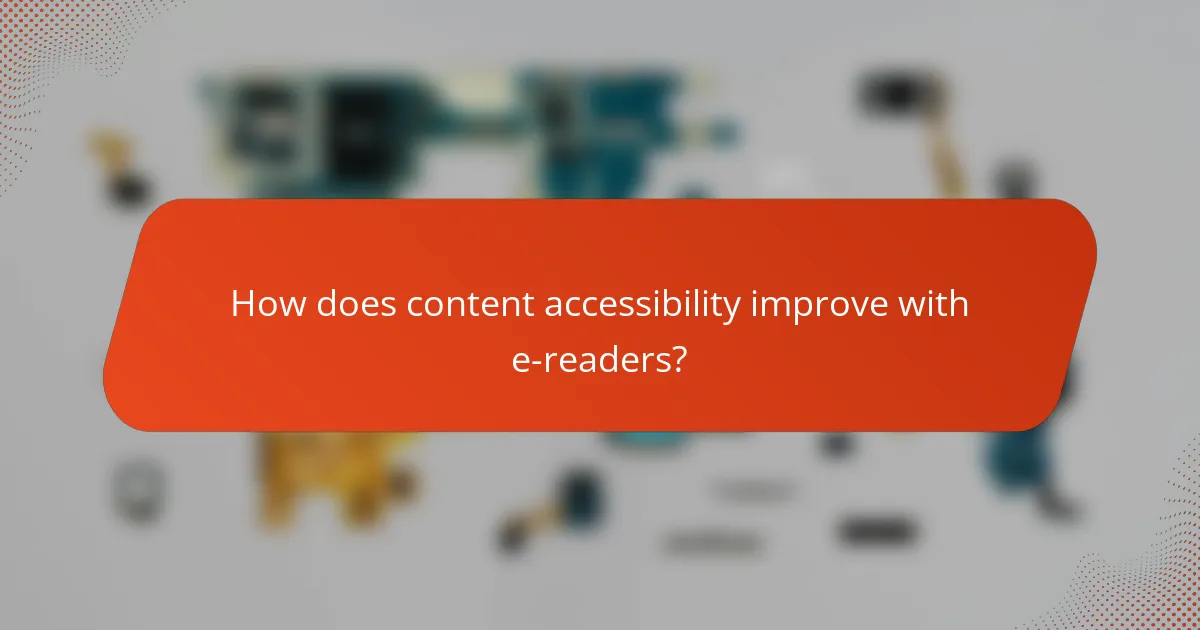
How does content accessibility improve with e-readers?
E-readers improve content accessibility by offering customizable text sizes and fonts. Users can adjust these settings to suit their visual preferences. Many e-readers include features like text-to-speech, allowing users to listen to content. This is particularly beneficial for individuals with visual impairments.
Additionally, e-readers provide options for background color changes, enhancing readability in various lighting conditions. They often support multiple file formats, making diverse content available. E-readers also include built-in dictionaries and translation tools, facilitating understanding of complex texts.
Research shows that e-readers can enhance reading comprehension for users with learning disabilities. A study by the University of California found that students using e-readers performed better in reading tasks compared to traditional books. This indicates that e-readers significantly enhance content accessibility for a wide range of users.
What types of content can be accessed through e-readers?
E-readers provide access to various types of content, primarily digital books, magazines, and newspapers. Users can download e-books in multiple formats, including EPUB and PDF. Many e-readers also support audiobooks and graphic novels. Additionally, users can access online articles and academic papers through integrated web browsers. Some e-readers offer access to cloud services for storing and retrieving content. This versatility enhances reading experiences by allowing users to carry an extensive library in a compact device.
How do e-readers facilitate access to a wider range of literature?
E-readers facilitate access to a wider range of literature by providing digital platforms for reading. They enable users to download thousands of books instantly. This instant access eliminates the need for physical storage space. E-readers often feature built-in bookstores, offering diverse genres and titles. Many e-readers support multiple formats, increasing the types of content available. They allow for easy updates and access to new releases. Additionally, they often include features like adjustable font sizes and background colors. These features enhance readability and cater to individual preferences.
What are the advantages of digital libraries and subscriptions for e-reader users?
Digital libraries and subscriptions provide e-reader users with extensive access to a variety of content. Users can access thousands of titles instantly. This eliminates the need for physical storage space. Digital libraries often offer lower costs compared to traditional book purchases. Subscriptions typically include a wide range of genres and formats. Users benefit from the convenience of reading anywhere at any time. Many digital libraries feature customizable reading options, enhancing user experience. Additionally, users can often borrow titles without late fees, as digital loans automatically expire.
How do e-readers support different formats and media?
E-readers support different formats and media by utilizing various file types and software compatibility. They typically handle formats like EPUB, PDF, MOBI, and AZW. This versatility allows users to access a wide range of content, including eBooks, articles, and magazines. Many e-readers also support audio files, enabling users to listen to audiobooks. Additionally, some devices offer features like note-taking and highlighting across different formats. E-readers often include built-in dictionaries and translation tools to enhance the reading experience. This multi-format support increases accessibility for diverse reading preferences and needs.
What formats are commonly supported by e-readers?
E-readers commonly support formats such as EPUB, PDF, MOBI, and AZW. EPUB is widely used for its reflowable content. PDF is popular for fixed-layout documents. MOBI is primarily associated with Amazon Kindle devices. AZW is a proprietary format developed by Amazon for its e-books. These formats ensure compatibility across various e-readers and provide diverse reading experiences.
How do multimedia features enhance the e-reading experience?
Multimedia features enhance the e-reading experience by providing interactive and engaging content. These features include videos, audio clips, and animations that can complement the text. They help to clarify complex concepts and make learning more enjoyable. Research shows that multimedia can improve retention rates by up to 50% compared to traditional text-only formats. Additionally, these features cater to different learning styles, accommodating visual and auditory learners. Overall, multimedia elements create a richer, more immersive reading environment that can lead to better comprehension and enjoyment.
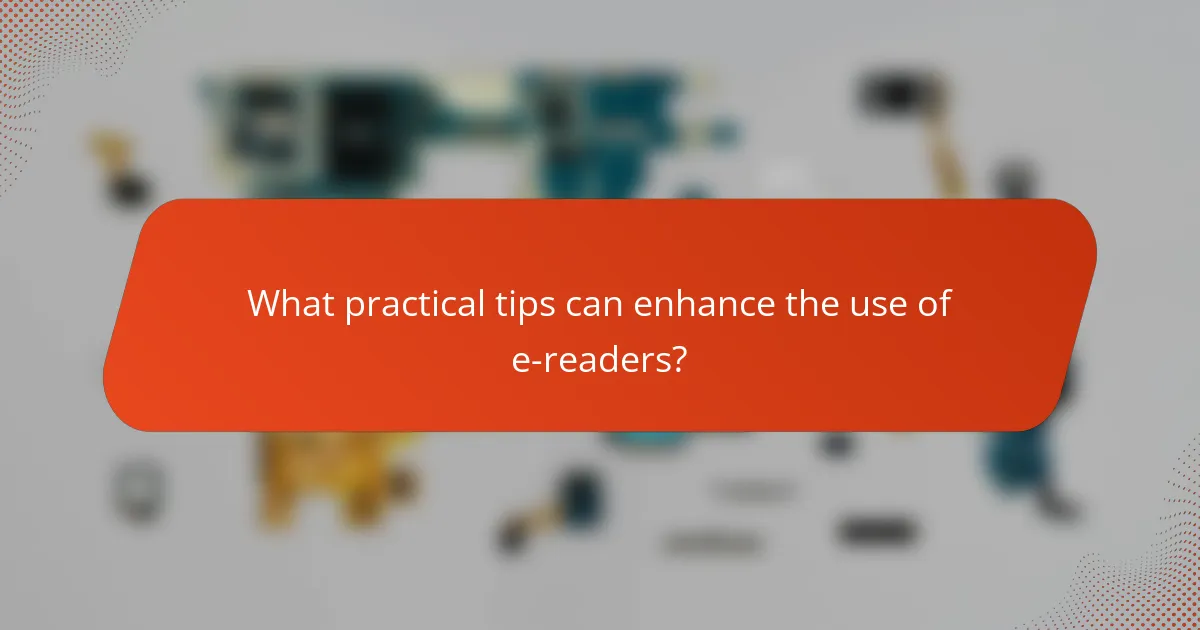
What practical tips can enhance the use of e-readers?
Adjust the brightness of the e-reader screen for comfortable reading. This reduces eye strain and enhances readability in various lighting conditions. Utilize built-in features like text size adjustment to improve accessibility. Larger fonts can aid in easier reading for those with visual impairments. Organize your library with collections for quick access to favorite titles. This can streamline your reading experience and save time. Take advantage of bookmarking and note-taking features to enhance engagement with the text. These tools help in retaining important information. Regularly update your e-reader software to ensure optimal performance and access to new features. Keeping the device updated can improve functionality and security. Finally, consider using a protective case to safeguard the e-reader from damage. This can prolong the device’s lifespan and maintain its condition.
How can users maximize their e-reader experience?
Users can maximize their e-reader experience by adjusting the screen brightness and font size. Proper brightness reduces eye strain during prolonged reading sessions. Customizing font size enhances readability and comfort based on individual preferences. Utilizing built-in dictionaries and note-taking features enriches understanding and engagement with the text. Organizing content into collections simplifies navigation and access to favorite books. Taking advantage of cloud storage ensures that users can access their library from multiple devices. Regularly updating the e-reader’s software improves performance and introduces new features. Engaging with online reading communities can provide recommendations and enhance the overall reading experience.
What settings should users adjust for optimal reading comfort?
Users should adjust brightness, font size, and contrast settings for optimal reading comfort. Brightness should match ambient light to reduce eye strain. A larger font size enhances readability, especially for longer texts. High contrast between text and background improves visibility. Additionally, users may benefit from selecting a warm color temperature to minimize blue light exposure. These adjustments can significantly enhance the overall reading experience on e-readers.
How can users effectively manage their digital libraries on e-readers?
Users can effectively manage their digital libraries on e-readers by organizing their content into collections. Collections help categorize books by genre, author, or reading status. Users can also utilize the search function to quickly locate specific titles. Regularly deleting unwanted or completed books frees up storage space. Syncing with cloud services ensures access to content across devices. Additionally, users should regularly update their e-reader software for optimal performance. These practices enhance the overall reading experience and maintain an organized digital library.
The main entity of this article is e-readers, which are digital devices designed for reading electronic books and other digital content. The article outlines the benefits of e-readers, focusing on key attributes such as screen technology, battery longevity, and content accessibility. It highlights how e-readers enhance the reading experience through features like adjustable lighting and font sizes, long battery life, and a wide range of accessible content formats. Additionally, the article discusses practical tips for maximizing the use of e-readers, including managing digital libraries and optimizing reading comfort through settings adjustments.
